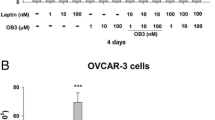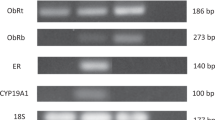Abstract
Leptin plays the role of mitogenic factor in the breast carcinogenesis. Therefore, it could be considered as a target for breast cancer therapy. Leptin gene expression could be modulated by activation of estrogen receptors. Silibinin is an herbal compound with anti-cancer activity on prostate and colorectal cancers. Based on the fact that targeting of leptin can be considered as a novel strategy for breast cancer therapy, the aim of this study was the investigation of potentiality of silibinin for inhibition of leptin gene expression and secretion, and its link with expression of estrogen receptors. Cytotoxic effect of silibinin on T47D breast cancer cells was investigated by MTT assay test after 24, 48 and 72 h treatments with different concentrations of silibinin. The levels of leptin, estrogen receptor α and estrogen receptor β genes expression was measured by reverse-transcription real-time PCR. The amount of secreted leptin in the culture medium was determined by ELISA. Data were statistically analyzed by one-way ANOVA test. Silibinin inhibits growth of T47D cells in a time and dose dependent manner. There was significant difference between control and treated cells in the levels of leptin, estrogen receptor β expression levels and the quantity of secreted leptin was decreased in the treated cells in comparison to control cells. In conclusion, silibinin inhibits the expression and the secretion of leptin and in the future it might probably be a drug candidate for breast cancer therapy through leptin targeting.




Similar content being viewed by others
References
Collins S, Kuhn CM, Petro AE, Swick AG, Chrunyk BA, Surwit RS (1996) Role of leptin in fat regulation. Nature 380:677
Dieudonne MN, Machinal-Quelin F, Serazin-Leroy V, Leneveu MC, Pecquery R, Giudicelli Y (2002) Leptin mediates a proliferative response in human MCF7 breast cancer cells. Biochem Biophys Res Commun 293:622–628
Fantuzzi G, Faggioni R (2000) Leptin in the regulation of immunity, inflammation, and hematopoiesis. J Leukoc Biol 68:437–446
Fazeli M, Zarkesh-Esfahani H, Wu Z, Maamra M, Bidlingmaier M, Pockley AG, Watson P, Matarese G, Strasburger CJ, Ross RJ (2006) Identification of a monoclonal antibody against the leptin receptor that acts as an antagonist and blocks human monocyte and T cell activation. J Immunol Methods 312:190–200
Garofalo C, Surmacz E (2006) Leptin and cancer. J Cell Physiol 207:12–22
Gonzalez RR, Watters A, Xu Y, Singh UP, Mann DR, Rueda BR, Penichet ML (2009) Leptin-signaling inhibition results in efficient anti-tumor activity in estrogen receptor positive or negative breast cancer. Breast Cancer Res 11:R36
Hardwick JC, Van Den Brink GR, Offerhaus GJ, Van Deventer SJ, Peppelenbosch MP (2001) Leptin is a growth factor for colonic epithelial cells. Gastroenterology 121:79–90
Hu X, Juneja SC, Maihle NJ, Cleary MP (2002) Leptin—a growth factor in normal and malignant breast cells and for normal mammary gland development. J Natl Cancer Inst 94:1704–1711
Ishikawa M, Kitayama J, Nagawa H (2004) Enhanced expression of leptin and leptin receptor (OB-R) in human breast cancer. Clin Cancer Res 10:4325–4331
Jemal A, Siegel R, Xu J, Ward E (2010) Cancer statistics 2010. CA Cancer J Clin 60:277–300
Kaur M, Agarwal R (2007) Silymarin and epithelial cancer chemoprevention: how close we are to bedside? Toxicol Appl Pharmacol 224:350–359
Koda M, Sulkowska M, Kanczuga-Koda L, Jarzabek K, Sulkowski S (2007) Expression of leptin and its receptor in female breast cancer in relation with selected apoptotic markers. Folia Histochem Cytobiol 45:S187–S191
Laud K, Gourdou I, Pessemesse L, Peyrat JP, Djiane J (2002) Identification of leptin receptors in human breast cancer: functional activity in the T47-D breast cancer cell line. Mol Cell Endocrinol 188:219–226
Lin CJ, Sukarieh R, Pelletier J (2009) Silibinin inhibits translation initiation: implications for anticancer therapy. Mol Cancer Ther 8:1606–1612
Liu Z, Uesaka T, Watanabe H, Kato N (2001) High fat diet enhances colonic cell proliferation and carcinogenesis in rats by elevating serum leptin. Int J Oncol 19:1009–1014
Livak KJ, Schmittgen TD (2001) Analysis of relative gene expression data using real-time quantitative PCR and the 2(−Delta Delta C(T)) method. Methods 25:402–408
Löffler S, Aust G, Köhler U, Spanel-Borowski K (2001) Evidence of leptin expression in normal and polycystic human ovaries. Mol Hum Reprod 7:1143–1149
Masuzaki H, Ogawa Y, Sagawa N, Hosoda K, Matsumoto T, Mise H, Nishimura H, Yoshimasa Y, Tanaka I, Mori T, Nakao K (1997) Nonadipose tissue production of leptin: leptin as a novel placenta-derived hormone in humans. Nat Med 3:1029–1033
Mix H, Widjaja A, Jandl O, Cornberg M, Kaul A, Göke M, Beil W, Kuske M, Brabant G, Manns MP, Wagner S (2000) Expression of leptin and leptin receptor isoforms in the human stomach. Gut 47:481–486
Morroni M, De Matteis R, Palumbo C, Ferretti M, Villa I, Rubinacci A, Cinti S, Marotti G (2004) In vivo leptin expression in cartilage and bone cells of growing rats and adult humans. J Anat 205:291–296
O’Neil JS, Burow ME, Green AE, McLachlan JA, Henson MC (2001) Effects of estrogen on leptin gene promoter activation in MCF-7 breast cancer and JEG-3 choriocarcinoma cells: selective regulation via estrogen receptors alpha and beta. Mol Cell Endocrinol 176:67–75
Oda A, Taniguchi T, Yokoyama M (2001) Leptin stimulates rat aortic smooth muscle cell proliferation and migration. Kobe J Med Sci 47:141–150
Peters JH, Simasko SM, Ritter RC (2007) Leptin analog antagonizes leptin effects on food intake and body weight but mimics leptin-induced vagal afferent activation. Endocrinology 148:2878–2885
Pourhassan M, Zarghami N, Rahmati M, Alibakhshi A, Ranjbari R (2010) The inhibitory effect of Curcuma longa extract on telomerase activity in A549 lung cancer cell line. Afr J Biotechnol 9:912–919
Ray A, Cleary MP (2010) Leptin as a potential therapeutic target for breast cancer prevention and treatment. Expert Opin Ther Targets 14:443–451
Seidlová-Wuttke D, Becker T, Christoffel V, Jarry H, Wuttke W (2003) Silymarin is a selective estrogen receptor beta (ERbeta) agonist and has estrogenic effects in the metaphysis of the femur but no or antiestrogenic effects in the uterus of ovariectomized (ovx) rats. J Steroid Biochem Mol Biol 86:179–188
Shin JH, Hur JY, Seo HS, Jeong YA, Lee JK, Oh MJ, Kim T, Saw HS, Kim SH (2007) The ratio of estrogen receptor alpha to estrogen receptor beta in adipose tissue is associated with leptin production and obesity. Steroids 72:592–599
Singh RP, Sharma G, Dhanalakshmi S, Agarwal C, Agarwal R (2009) Suppression of advanced human prostate tumor growth in athymic mice by silibinin feeding is associated with reduced cell proliferation, increased apoptosis, and inhibition of angiogenesis. Mol Cancer Ther 8:1606–1612
Solberg R, Aas V, Thoresen GH, Kase ET, Drevon CA, Rustan AC, Reseland JE (2005) Leptin expression in human primary skeletal muscle cells is reduced during differentiation. J Cell Biochem 96:89–96
Soyupek S, Armağan A, Serel TA, Hoşcan MB, Perk H, Karaöz E, Candir O (2005) Leptin expression in the testicular tissue of fertile and infertile men. Arch Androl 51:239–246
Tartaglia LA (1997) The leptin receptor. J Biol Chem 272:6093–6096
Tiwari P, Kumar A, Balakrishnan S, Kushwaha HS, Mishra KP (2011) Silibinin-induced apoptosis in MCF7 and T47D human breast carcinoma cells involves caspase-8 activation and mitochondrial pathway. Cancer Invest 29:12–20
Vona-Davis L, Rose DP (2007) Adipokines as endocrine, paracrine, and autocrine factors in breast cancer risk and progression. Endocr Relat Cancer 14:189–206
Yi KW, Shin JH, Seo HS, Lee JK, Oh MJ, Kim T, Saw HS, Kim SH, Hur JY (2008) Role of estrogen receptor-alpha and -beta in regulating leptin expression in 3T3-L1 adipocytes. Obesity (Silver Spring) 16:2393–2399
Zhang Y, Proenca R, Maffei M, Barone M, Leopold L, Friedman JM (1994) Positional cloning of the mouse obese gene and its human homologue. Nature 372:425–432
Acknowledgments
The authors would like to thank Tuberculosis and Lung Disease Research Center for granting of this work and also Drug Applied Research Center for technical assistance. Both of these centers are affiliated to Tabriz University of Medical Sciences, Tabriz, Iran. The authors declare that the abstract of current work has been presented as poster at “First international meeting on Cellular and Molecular Advances in Non-Contagious Diseases (May 2011, Babol City, Iran)” and published in the meeting journal (Cell Journal, Vol. 13, Supplement 2).
Conflict of interest
The authors have no competing interests.
Author information
Authors and Affiliations
Corresponding author
Rights and permissions
About this article
Cite this article
Nejati-Koshki, K., Zarghami, N., Pourhassan-Moghaddam, M. et al. Inhibition of leptin gene expression and secretion by silibinin: possible role of estrogen receptors. Cytotechnology 64, 719–726 (2012). https://doi.org/10.1007/s10616-012-9452-3
Received:
Accepted:
Published:
Issue Date:
DOI: https://doi.org/10.1007/s10616-012-9452-3




